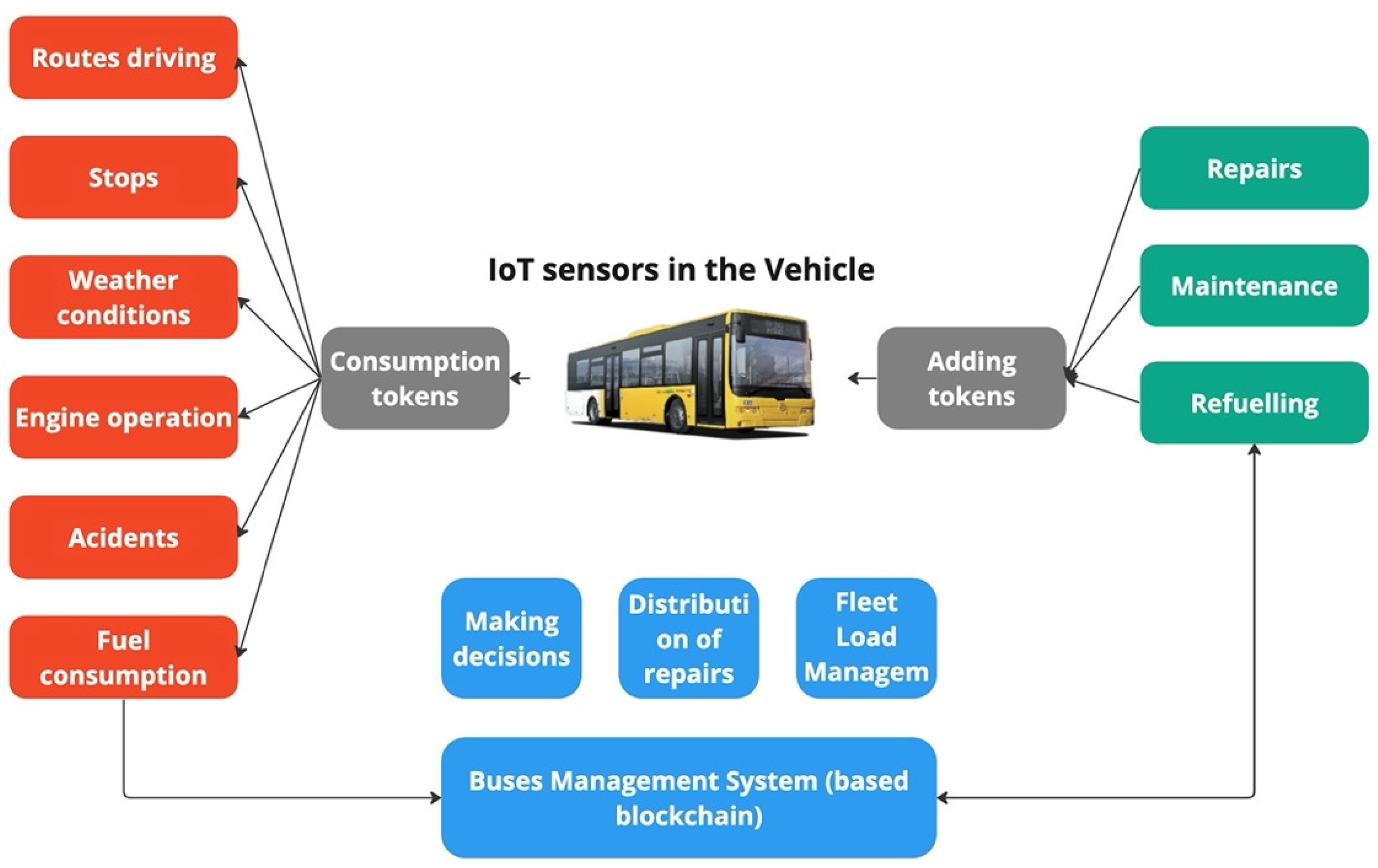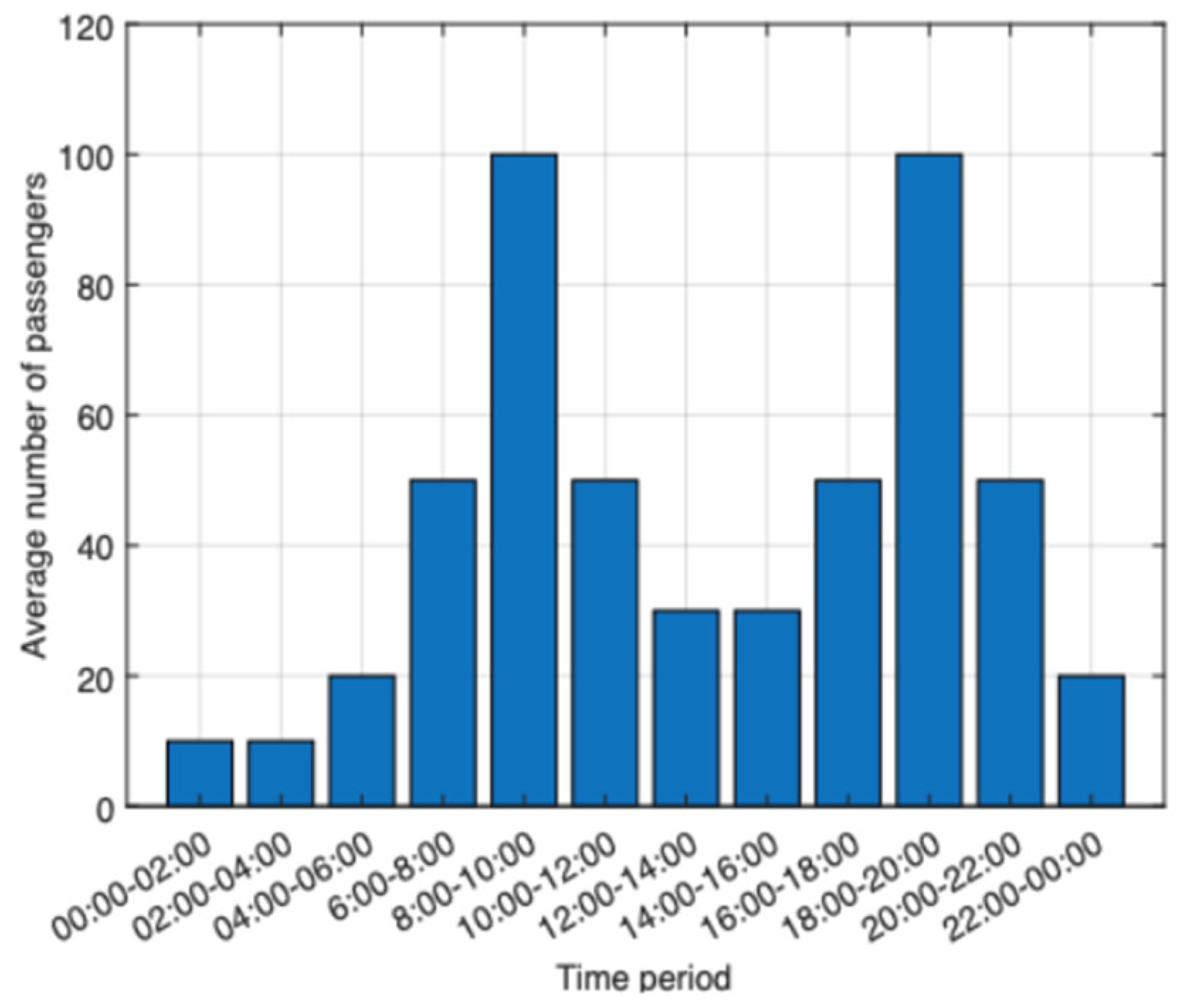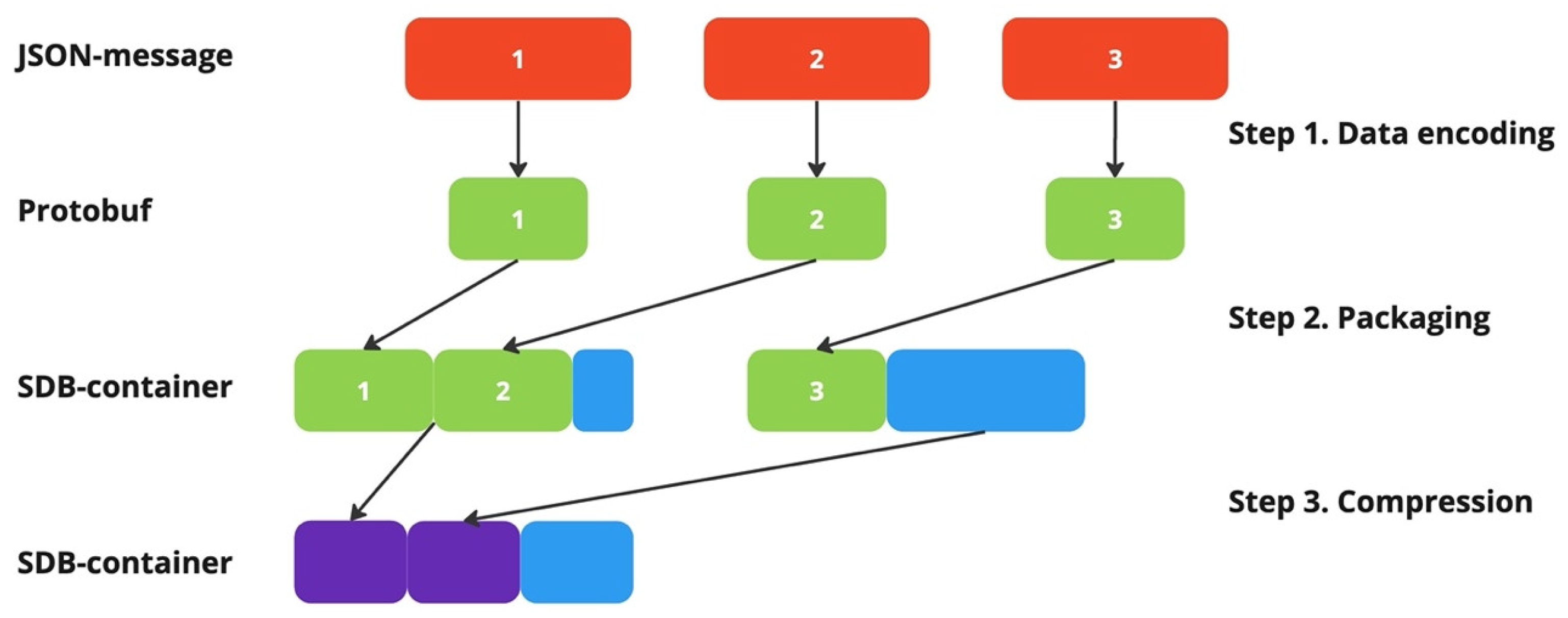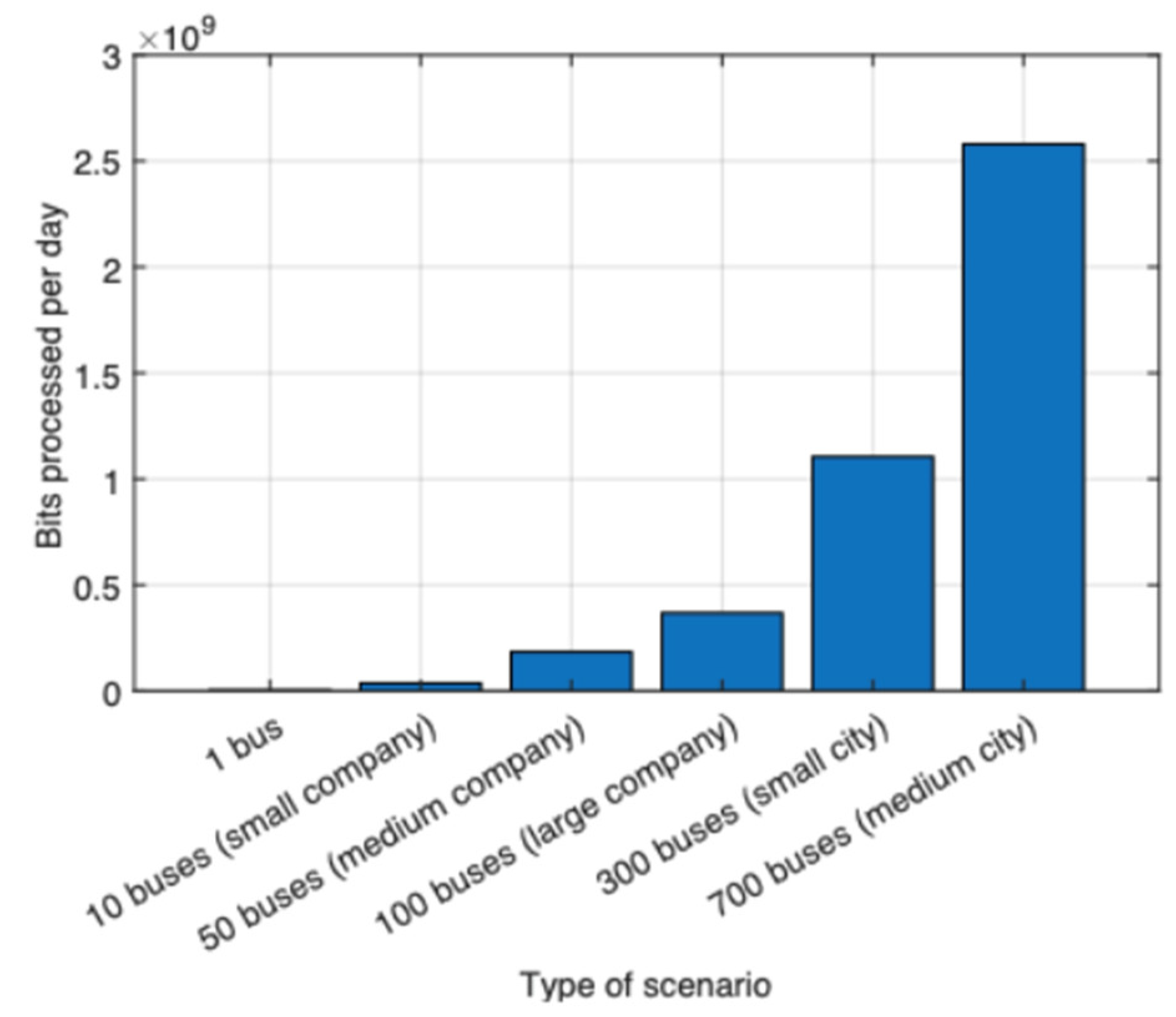Decentralized Public Transport Management System Based on Blockchain Technology †
Abstract
1. Introduction
- RQ1: Is it possible to improve the efficiency of public transport maintenance and repair with the help of modern technologies?
- RQ2: Could their application effectively ensure the uninterrupted and safe transportation of passengers?
- RQ3: Will such a system be an effective management tool for transport organizations?
- The development of an innovative tokenization approach for vehicle condition monitoring, where each transport unit is represented as a macro-token subdivided into 500,000 micro-tokens, enabling the precise tracking of vehicle resource consumption and maintenance needs.
- The creation of a mathematical model for vehicle state assessment that incorporates multiple operational factors, including mileage, passenger load, weather conditions, and maintenance history, providing a comprehensive framework for condition monitoring.
- The introduction of the GDEPZ method for optimizing data transmission via satellite communication, specifically designed for vehicles operating in remote areas with limited connectivity.
2. Related Work and Background
2.1. Intelligent Transport Systems and Urban Logistics
2.2. Safety and Implementation Challenges
2.3. Supply Chain Financing
2.4. Related Works Summary
- Reductions in maintenance costs and downtime due to the introduction of a more honest mechanism for monitoring vehicle resources;
- Improving the fault tolerance of the overall transportation system through the predictable and realistic management of expectations for vehicle capabilities;
- Increasing the level of data analytics and confidence in the framework of transport system management.
3. System Design and Implementation
3.1. Token-Based Vehicle Monitoring Model
- —the value of the quality token;
- —the reduction metric;
- —the increase metric;
- —the reduction ratio;
- —the increase ratio;
- The formula for calculating the current state of a vehicle’s quality, used to determine the required maintenance, is as follows:
- It will stay operational for 40 days;
- It will be capable of transporting 20,000 people;
- It will have 80 driver shifts;
- It will have an operational time of 600 h;
- It will make, at minimum, 1600 stops.
3.2. Data Collection and Transmission
- The type of vehicle;
- The number of IoT sensors per vehicle;
- A variety of options for the transmitted information;
- The frequency of data transmission.
3.3. Proposed System Description
- Operational Control: Private blockchains allow for complete control over network parameters and transaction validation, which is crucial for maintaining the required transaction processing capacity.
- Data Privacy: Public transport organizations need to maintain control over sensitive operational data while still ensuring transparency within their organization.
- System Efficiency: Our implementation requires processing a specific number of vehicle tokens, which is more efficiently managed within a private blockchain structure.
- Geographical Scope: Since the system is designed to operate within one geographical area, a private blockchain provides sufficient decentralization while maintaining operational efficiency.
- First, we define the SBD packets as having a size V and a set of n messages of sizes , … . It is necessary to find an integer number of containers B and partition the set {1,…,n} into B subsets , … such that we obtain the following:
- V—the volume of the container in bytes;
- n—the number of messages from sensors in the buffer;
- —the volume of the i-th message in bytes;
- B—number of containers;
- —equals 1 if container i is used or 0 otherwise;
- —equals 1 if message j is placed in container I;
- —is an operator for compressing messages placed in a container.
- The task is to minimize under the set constraints.
- The total size of messages placed in the container and then compressed by the compression operator cannot exceed the size of the container:
3.4. Description of the Operation of the Compression Algorithm
- V1—the amount of data placed in the container to be sent in bytes;
- V2—the volume of primary data from the IoT sensors in bytes;
- V3—the volume of serialized primary data from the IoT sensors;
- V4—the amount of uncompressed data placed in the container;
- V5—the volume of compressed data placed in the container;
- K1—compression ratio for the serialization of primary data from the IoT sensors (conversion to binary format);
- K2—compression ratio when placing data in a container;
- K3—the compression ratio in the data container after applying the compression operator (algorithm).
- Then, the amount of data placed in the container for sending can be determined as follows:
- L—the useful amount of data from IoT sensors in bits, with a 1-bit data transfer rate/sec;
- C—the transfer rate of containers (SBD packets);
- T—the data transfer time.
- Then, we obtain the following:
3.5. Data Encoding and Packaging Method
4. Results and System Evaluation
4.1. Comparison with Traditional Management Systems
4.2. Decision-Making Scenarios
- Schedules maintenance within the next 48 h.
- Adjusts route assignments to minimize additional wear.
- Notifies maintenance crews with specific component diagnostics.
- The token depletion rate is dynamically adjusted.
- Maintenance thresholds are automatically lowered.
- Additional diagnostic checks are scheduled.
- Immediate diagnostic procedures are initiated.
- Real-time alerts are sent to operations management.
- Preventive maintenance is scheduled based on pattern analysis.
4.3. Performance Analysis
- The method reduces the data volume with a common linguistic feature ranging from 30 to 2048 bytes by 10–17 times (4.6 times due to serialization and 2.13–3.6 times due to the authors’ proposed archiving method);
- The cost reduction in data transmission leads to an increased economic efficiency of satellite communications for organizing data transmission networks in remote areas lacking telecommunication infrastructure;
- The method can be further refined and generalized for satellite IoT scenarios using various combinations of data transmission technologies, encoding formats, and container sizes.
- The maximum size of the sent message is 340 bytes;
- The maximum size of the received message is 270 bytes.
- The maximum packet size for transmission is 1960 bytes (SBD);
- The maximum packet size for reception is 1890 bytes (SBD).
4.4. Limitations and Challenges
5. Discussion and Future Perspectives
5.1. Future Research Directions and Application in Unmanned Transport
- Parking place (depot);
- Place of service;
- Stopping points along the route;
- Route from the depot to the beginning of the route;
- Route from the end of the route to the depot;
- Route between the depot and the service station;
- Route between each stop and the service station.
5.2. System Advantages
- Reduction in labor costs.
- Reduction in administrative management costs.
- Improvement in the quality of driving equipment on the route.
- Increase in the speed of decision making in the transport system.
- Reduction in maintenance and repair errors.
- Improvement in the reliability and service life of vehicles.
6. Conclusions
- Operational efficiency: The tokenization system enables predictive maintenance planning, reducing unexpected breakdowns and operational costs.
- Data management: The GDEPZ method optimizes data transmission, making the system viable even in areas with limited connectivity.
- Decision making: The mathematical model provides objective criteria for maintenance decisions, eliminating subjective factors and improving overall fleet reliability.
Author Contributions
Funding
Institutional Review Board Statement
Informed Consent Statement
Data Availability Statement
Conflicts of Interest
References
- Borro, D.; Suescun, Á.; Brazález, A.; González, J.M.; Ortega, E.; González, E. WARM: Wearable AR and Tablet-Based Assistant Systems for Bus Maintenance. Appl. Sci. 2021, 11, 1443. [Google Scholar] [CrossRef]
- Waycaster, G.C.; Matsumura, T.; Bilotkach, V.; Haftka, R.T.; Kim, N.H. Review of regulatory emphasis on transportation safety in the united states, 2002–2009: Public versus private modes. Risk Anal. 2018, 38, 1085–1101. [Google Scholar] [CrossRef] [PubMed]
- Houbbadi, A.; Trigui, R.; Pelissier, S.; Redondo-Iglesias, E.; Bouton, T. Optimal Scheduling to Manage an Electric Bus Fleet Overnight Charging. Energies 2019, 12, 2727. [Google Scholar] [CrossRef]
- Volkov, V.; Taran, I.; Volkova, T.; Pavlenko, O.; Berezhnaja, N. Determining the efficient management system for a spe-cialized transport enterprise. Sci. Bull. Natl. Min. Univ. 2020, 4, 185–191. [Google Scholar]
- Gorbunova, M.; Masek, P.; Komarov, M.; Ometov, A. Distributed ledger technology: State-of-the-art and current challenges. Comput. Sci. Inf. Syst. 2022, 19, 65–85. [Google Scholar] [CrossRef]
- Bodkhe, U.; Tanwar, S.; Parekh, K.; Khanpara, P.; Tyagi, S.; Kumar, N.; Alazab, M. Blockchain for industry 4.0: A compre-hensive review. IEEE Access 2020, 8, 79764–79800. [Google Scholar] [CrossRef]
- Helo, P.; Hao, Y. Blockchains in operations and supply chains: A model and reference implementation. Comput. Ind. Eng. 2019, 136, 242–251. [Google Scholar] [CrossRef]
- Kechagiasa, G.A.; Diamantidisa, A.C.; Dimitrakosb, T.D.; Tsakalerouc, M. Optimal maintenance of deteriorating equipment using semi-Markov decision processes and linear programming. Int. J. Ind. Eng. Manag. 2024, 15, 81–95. [Google Scholar] [CrossRef]
- Softic, S.; Hrnjica, B. Case Studies of Survival Analysis for Predictive Maintenance in Manufacturing. Int. J. Ind. Eng. Manag. 2024, 15, 320–337. [Google Scholar] [CrossRef]
- Al-Refaie, A.; Al-Hawadi, A.; Lepkova, N. Blockchain Design with Optimal Maintenance Planning. Buildings 2022, 12, 1902. [Google Scholar] [CrossRef]
- Jha, S.; Jha, N.; Prashar, D.; Ahmad, S.; Alouffi, B.; Alharbi, A. Integrated iot-based secure and efficient key management framework using hashgraphs for autonomous vehicles to ensure road safety. Sensors 2022, 22, 2529. [Google Scholar] [CrossRef]
- Abdel-Basset, M.; Moustafa, N.; Hawash, H.; Razzak, I.; Sallam, K.M.; Elkomy, O.M. Federated Intrusion Detection in Blockchain-Based Smart Transportation Systems. IEEE Trans. Intell. Transp. Syst. 2021, 23, 2523–2537. [Google Scholar] [CrossRef]
- Singh, P.K.; Singh, R.; Nandi, S.K.; Ghafoor, K.Z.; Rawat, D.B.; Nandi, S. Blockchain-Based Adaptive Trust Management in Internet of Vehicles Using Smart Contract. IEEE Trans. Intell. Transp. Syst. 2020, 22, 3616–3630. [Google Scholar] [CrossRef]
- Arooj, A.; Farooq, M.S.; Akram, A.; Iqbal, R.; Sharma, A.; Dhiman, G. Big data processing and analysis in internet of vehicles: Architecture, taxonomy, and open research challenges. Arch. Comput. Methods Eng. 2022, 29, 793–829. [Google Scholar] [CrossRef]
- Ometov, A.; Bezzateev, S.; Davydov, V.; Shchesniak, A.; Masek, P.; Lohan, E.S.; Koucheryavy, Y. Positioning Information Privacy in Intelligent Transportation Systems: An Overview and Future Perspective. Sensors 2019, 19, 1603. [Google Scholar] [CrossRef] [PubMed]
- Qureshi, K.N.; Jeon, G.; Hassan, M.M.; Hassan, R.; Kaur, K. Blockchain-Based Privacy-Preserving Authentication Model Intelligent Transportation Systems. IEEE Trans. Intell. Transp. Syst. 2022, 24, 7435–7443. [Google Scholar] [CrossRef]
- Stepanov, N.; Veprev, A.; Sharapova, A.; Alekseeva, D.; Komarov, M.; Lohan, E.S.; Ometov, A. On machine learning ap-plicability to transaction time prediction for time-critical c-its applications. In Proceedings of the 44th International Conference on Tele-communications and Signal Processing (TSP), Brno, Czech Republic, 26–28 July 2021; IEEE: New York, NY, USA, 2021; pp. 408–413. [Google Scholar]
- Chen, X.; Ding, J.; Lu, Z. A Decentralized Trust Management System for Intelligent Transportation Environments. IEEE Trans. Intell. Transp. Syst. 2020, 23, 558–571. [Google Scholar] [CrossRef]
- Reddy, K.R.K.; Gunasekaran, A.; Kalpana, P.; Sreedharan, V.R.; Kumar, S.A. Developing a blockchain framework for the automotive supply chain: A systematic review. Comput. Ind. Eng. 2021, 157, 107334. [Google Scholar] [CrossRef]
- Maffiola, D.; Longari, S.; Carminati, M.; Tanelli, M.; Zanero, S. GOLIATH: A Decentralized Framework for Data Collection in Intelligent Transportation Systems. IEEE Trans. Intell. Transp. Syst. 2021, 23, 13372–13385. [Google Scholar] [CrossRef]
- Patro, P.K.; Ahmad, R.W.; Yaqoob, I.; Salah, K.; Jayaraman, R. Blockchain-Based Solution for Product Recall Management in the Automotive Supply Chain. IEEE Access 2021, 9, 167756–167775. [Google Scholar] [CrossRef]
- Shahbazi, Z.; Byun, Y.-C. A framework of vehicular security and demand service prediction based on data analysis inte-grated with blockchain approach. Sensors 2021, 21, 3314. [Google Scholar] [CrossRef]
- Tian, Z.; Zhong, R.Y.; Barenji, A.V.; Wang, Y.T.; Li, Z.; Rong, Y. A blockchain-based evaluation approach for customer delivery satisfaction in sustainable urban logistics. Int. J. Prod. Res. 2021, 59, 2229–2249. [Google Scholar] [CrossRef]
- Zhang, X.; Wang, D. Adaptive Traffic Signal Control Mechanism for Intelligent Transportation Based on a Consortium Blockchain. IEEE Access 2019, 7, 97281–97295. [Google Scholar] [CrossRef]
- Chen, C.-L.; Yang, J.; Tsaur, W.-J.; Weng, W.; Wu, C.-M.; Wei, X. Enterprise Data Sharing with Privacy-Preserved Based on Hyperledger Fabric Blockchain in IIOT’s Application. Sensors 2022, 22, 1146. [Google Scholar] [CrossRef] [PubMed]
- Lakhan, A.; Mohammed, M.A.; Ibrahim, D.A.; Kadry, S.; Abdulkareem, K.H.; Rashid, A.N.; Nedoma, J.; Martinek, R.; Razzak, I. ITS Based on Deep Graph Convolutional Fraud Detection Network Blockchain-Enabled Fog-Cloud. IEEE Trans. Intell. Transp. Syst. 2022, 24, 8399–8408. [Google Scholar] [CrossRef]
- Sharma, P.K.; Park, J.H. Blockchain-Based Secure Mist Computing Network Architecture for Intelligent Transportation Systems. IEEE Trans. Intell. Transp. Syst. 2020, 22, 5168–5177. [Google Scholar] [CrossRef]
- Kumar, R.; Kumar, P.; Tripathi, R.; Gupta, G.P.; Kumar, N.; Hassan, M.M. A Privacy-Preserving-Based Secure Framework Using Blockchain-Enabled Deep-Learning in Cooperative Intelligent Transport System. IEEE Trans. Intell. Transp. Syst. 2021, 23, 16492–16503. [Google Scholar] [CrossRef]
- Wang, Q.; Ji, T.; Guo, Y.; Yu, L.; Chen, X.; Li, P. TrafficChain: A Blockchain-Based Secure and Privacy-Preserving Traffic Map. IEEE Access 2020, 8, 60598–60612. [Google Scholar] [CrossRef]
- Mathivathanan, D.; Mathiyazhagan, K.; Rana, N.P.; Khorana, S.; Dwivedi, Y.K. Barriers to the adoption of blockchain technology in business supply chains: A total interpretive structural modelling (TISM) approach. Int. J. Prod. Res. 2021, 59, 3338–3359. [Google Scholar] [CrossRef]
- Raj, P.V.R.P.; Jauhar, S.K.; Ramkumar, M.; Pratap, S. Procurement, traceability and advance cash credit payment trans-actions in supply chain using blockchain smart contracts. Comput. Ind. Eng. 2022, 167, 108038. [Google Scholar] [CrossRef]
- Du, M.; Chen, Q.; Xiao, J.; Yang, H.; Ma, X. Supply Chain Finance Innovation Using Blockchain. IEEE Trans. Eng. Manag. 2020, 67, 1045–1058. [Google Scholar] [CrossRef]
- Liu, L.; Li, Y.; Jiang, T. Optimal strategies for financing a three-level supply chain through blockchain platform finance. Int. J. Prod. Res. 2021, 61, 3564–3581. [Google Scholar] [CrossRef]
- Dong, C.; Chen, C.; Shi, X.; Ng, C.T. Operations strategy for supply chain finance with asset-backed securitization: Cen-tralization and blockchain adoption. Int. J. Prod. Econ. 2021, 241, 108261. [Google Scholar] [CrossRef]
- Li, Y.; Jiang, S.; Shi, J.; Wei, Y. Pricing strategies for blockchain payment service under customer heterogeneity. Int. J. Prod. Econ. 2021, 242, 108282. [Google Scholar] [CrossRef]
- Muller, W.A.L.; Garzon, R. Hidals: A hybrid iot-based decentralized application for logistics and supply chain man-agement. In Proceedings of the 2019 IEEE 10th Annual Information Technology, Electronics and Mobile Communication Conference (IEMCON), Vancouver, BC, Canada, 17–19 October 2019. [Google Scholar]
- Khoshavi, N.; Tristani, G.; Sargolzaei, A. Blockchain applications to improve operation and security of transportation systems: A survey. Elec-Tronics 2021, 10, 629. [Google Scholar] [CrossRef]
- Della Valle, F.; Oliver, M. Blockchain-Based Information Management for Supply Chain Data-Platforms. Appl. Sci. 2021, 11, 8161. [Google Scholar] [CrossRef]
- Wang, Y.; Singgih, M.; Wang, J.; Rit, M. Making sense of blockchain technology: How will it transform supply chains? Int. J. Prod. Econ. 2019, 211, 221–236. [Google Scholar] [CrossRef]
- Al-Farsi, S.; Rathore, M.M.; Bakiras, S. Security of Blockchain-Based Supply Chain Management Systems: Challenges and Opportunities. Appl. Sci. 2021, 11, 5585. [Google Scholar] [CrossRef]
- Lohmer, J.; Bugert, N.; Lasch, R. Analysis of resilience strategies and ripple effect in blockchain-coordinated supply chains: An agent-based simulation study. Int. J. Prod. Econ. 2020, 228, 107882. [Google Scholar] [CrossRef]
- Queiroz, M.M.; Wamba, S.F.; De Bourmont, M.; Telles, R. Blockchain adoption in operations and supply chain man-agement: Empirical evidence from an emerging economy. Int. J. Prod. Res. 2021, 59, 6087–6103. [Google Scholar] [CrossRef]
- Wu, C.-H.; Tsang, Y.-P.; Lee, C.K.-M.; Ching, W.-K. A Blockchain-IoT Platform for the Smart Pallet Pooling Management. Sensors 2021, 21, 6310. [Google Scholar] [CrossRef] [PubMed]
- Perboli, G.; Musso, S.; Rosano, M. Blockchain in Logistics and Supply Chain: A Lean Approach for Designing Real-World Use Cases. IEEE Access 2018, 6, 62018–62028. [Google Scholar] [CrossRef]
- Guevara, L.; Auat Cheein, F. The Role of 5G Technologies: Challenges in Smart Cities and Intelligent Transportation Systems. Sustainability 2020, 12, 6469. [Google Scholar] [CrossRef]
- Connolly, D.; Martello, S.; Toth, P. Knapsack Problems: Algorithms and Computer Implementations. J. Oper. Res. Soc. 1991, 42, 513. [Google Scholar] [CrossRef]
- Voskov, L.; Rolich, A.; Bakanov, G.; Podkopaeva, P. Gateway data encoding, packaging and compression method for heterogeneous iot-satellite network. In Proceedings of the 2021 XVII International Symposium “Problems of Redundancy in Information and Control Systems” (REDUNDANCY), Moscow, Russia, 25–29 October 2021. [Google Scholar]
- Lysogor, I.; Voskov, L.; Rolich, A.; Efremov, S. Study of data transfer in a heterogeneous lora-satellite network for the internet of remote things. Sensors 2019, 19, 3384. [Google Scholar] [CrossRef]




| Application Domain | Key Features | Implementation Challenges | References |
|---|---|---|---|
| Intelligent Transport Systems | Security and data integrity | Scalability | (Jha et al., 2022) [11] |
| Real-time data exchange | Network latency | (Abdel-Basset et al., 2021) [12] | |
| Decentralized trust | |||
| Safety Management | Transparent monitoring | Integration costs | (Chen et al., 2022) [25] |
| Secure data sharing | System complexity | (Kumar et al., 2021) [28] | |
| Fraud prevention | |||
| Supply Chain and Logistics | Asset tracking | Implementation barriers | (Reddy et al., 2021) [19] |
| Smart contracts | Technology adoption | (Maffiola et al., 2021) [20] | |
| Process automation |
| Metric | Description | Token Change, Units |
|---|---|---|
| One mileage kilometer | Every kilometer reduction. | −4 |
| One passenger | Each transported passenger reduction. | −3 |
| One stop | Each stop reduction. | −35 |
| Temperature conditions | Working outside the target temperature conditions (below −20 and above 25 degrees Celsius), reduction according to the delta temperature formula from the border * 200. The average daily temperature is taken. | [−200; −4000] |
| Precipitation amount | Precipitation in the form of snow or rain reduction | −1000 |
| A traffic accident | A blocking incident requiring a return to the park for inspection and recovery. An accident is understood as any emergency situation involving other road users or not. | −300,000 |
| One change of drivers | Each shift for a new driver (including the first exit per shift) reduction. | −750 |
| One engine hour | Every hour of engine operation reduction. | −100 |
| Metric | Description | Token Change, Units |
|---|---|---|
| Routine maintenance | General inspection of the bus. Some units are checked according to the regulations every 30,000 km, most of them every 15,000 km | 200,000 |
| Replacing the coolant | Every 30,000 km | 20,000 |
| Replacement of fuel purification filters | Every 30,000 km | 20,000 |
| Oil and oil filter replacement | Every 15,000 km | 20,000 |
| Oil change in the gearbox | Every 60,000 km | 20,000 |
| Oil change in the rear axle crankcase | Every 60,000 km | 20,000 |
| Replacement of brake pads | Every 60,000 km | 40,000 |
| Rubber replacement | Every 6 months | 10,000 |
| Washing | Washing a vehicle | 1000 |
| Repair after an accident | Restoration work after any accident | 300,000 |
| Source | Data Type | Data Transmission Frequency |
|---|---|---|
| Engine speed, vehicle speed | Word | One per minute |
| Temperature of engine oil, antifreeze | Integer | One per minute |
| Check engine | Boolean | One per 30 min |
| The mileage of a vehicle | Integer | One per day |
| Wear of brake pads and discs | Byte | One per day |
| Number of stops, passengers, drivers | Word | One per day |
| Engine running time | Datetime | One per day |
| Vehicle location | Geometry | One per minute |
| Characteristic | Value | Background |
|---|---|---|
| Network capacity | Twenty-Five Transactions Per Second (TPS) | The number of buses in 1 city with a population of up to 1 million is up to 1500 units. It is necessary to receive the status of transactions and technical conditions at least once every 60 s. This means that the network bandwidth is sufficient at the level of 25 TPS. |
| The number of tokens | 1500 tokens | We divide each token into 500 thousand parts. |
| Type of tokens | Stablecoins | Each token is provided with 1 real vehicle |
| Token Standard | ERC-721 | Each asset (vehicle) is unique and not interchangeable. There is no task to exchange with other tokens since the solution works completely in a private blockchain. |
| Issue of tokens | Possible | When expanding the participants using the proposed system. |
| Architectural Layer | Components | Functionality |
|---|---|---|
| Smart Contract Layer | ERC-721 token contract State management contract Maintenance trigger contract Access control contract | Vehicle token management Value modification handling Automated maintenance scheduling Permission management |
| Consensus and Validation Layer | PoA consensus mechanism Transaction validation Node configuration Real-time updates | 25 TPS throughput optimization Private network operation Token value validation System performance monitoring |
| Data Management Layer | Maintenance history storage Token value transactions IoT data integration Event logging | Immutable record keeping Value modification tracking Sensor data processing Maintenance event recording |
| Parameter for Comparison | Traditional Service Management System | Service Management Using Blockchain |
|---|---|---|
| Process Holder | Chief mechanic or head of a transport company | The rules are written in the private blockchain |
| Accounting of the order and time of service provision | Manually based on the manufacturer’s instructions | Automatically based on the actual operating conditions of the vehicle |
| The number of errors in the process of organizing maintenance | Constantly, as it depends on the human factor | It is reduced as the blockchain is used, as the system is calibrated as it is filled with data |
| Transportation safety | Depends on the decency of the staff | Depends on the calibration of the system, the level increases over time |
| The speed of making a decision about the need for maintenance | Several days | Instantly |
| Managing repair and maintenance history | Centralized, depends on specific people | Decentralized, can be transferred to a new management |
| Maintenance costs | Not controlled. Identified upon the fact of breakdowns or according to the maintenance regulations | Seeks to reduce by rationalizing the repair plan |
Disclaimer/Publisher’s Note: The statements, opinions and data contained in all publications are solely those of the individual author(s) and contributor(s) and not of MDPI and/or the editor(s). MDPI and/or the editor(s) disclaim responsibility for any injury to people or property resulting from any ideas, methods, instructions or products referred to in the content. |
© 2025 by the authors. Licensee MDPI, Basel, Switzerland. This article is an open access article distributed under the terms and conditions of the Creative Commons Attribution (CC BY) license (https://creativecommons.org/licenses/by/4.0/).
Share and Cite
Trofimov, S.; Voskov, L.; Komarov, M. Decentralized Public Transport Management System Based on Blockchain Technology. Appl. Sci. 2025, 15, 1348. https://doi.org/10.3390/app15031348
Trofimov S, Voskov L, Komarov M. Decentralized Public Transport Management System Based on Blockchain Technology. Applied Sciences. 2025; 15(3):1348. https://doi.org/10.3390/app15031348
Chicago/Turabian StyleTrofimov, Stanislav, Leonid Voskov, and Mikhail Komarov. 2025. "Decentralized Public Transport Management System Based on Blockchain Technology" Applied Sciences 15, no. 3: 1348. https://doi.org/10.3390/app15031348
APA StyleTrofimov, S., Voskov, L., & Komarov, M. (2025). Decentralized Public Transport Management System Based on Blockchain Technology. Applied Sciences, 15(3), 1348. https://doi.org/10.3390/app15031348










